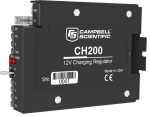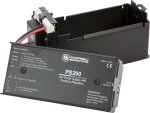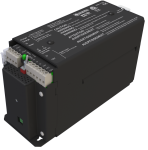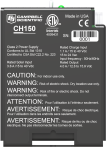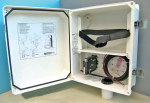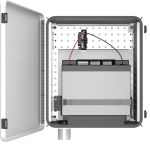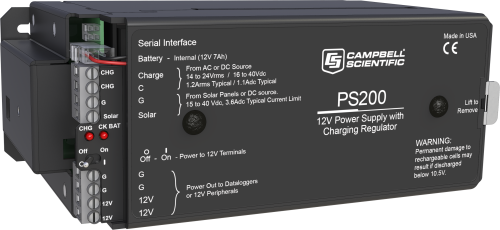
Manages voltage and amperage to protect battery






Overview
The PS200 is a 12-Vdc battery with a charge controller. The controller manages amperage and voltage for safe, optimized battery charging from a solar-panel or AC power source. It also measures various input, output, and status parameters to allow close monitoring of the battery during charging and use. The PS200 includes a 12-Vdc lead-acid battery, while the CH200 is for use with a user-supplied battery.
Note: If you do not need or desire the 6182 7 Ah Sealed Rechargeable Battery that is shipped with the PS200, consider ordering the 22238 instead.
Read MoreBenefits and Features
- Protects against high-amperage and high-voltage damage to power supply
- Ability to monitor both load and battery current
- Battery reversal protection
- Real-time measurements of charge input voltage, battery voltage, on-board temperature, battery current, and load current
- Two-step constant voltage charging and temperature compensation optimize battery charging and increase the battery’s life
- Allows simultaneous connection of two charging sources (e.g., solar panel, ac wall charger)
Images


















CAD Files:
Similar Products
Detailed Description
The PS200 power supply consists of a rechargeable, 7 A h, valve-regulated lead-acid (VRLA) battery and a charging regulator. This microcontroller-based smart charger has two-step constant voltage charging and temperature compensation that optimize battery charging and increase the battery’s life.
Two input terminals enable simultaneous connection of two charging sources. The PS200 also incorporates a maximum power point tracking algorithm for solar inputs that maximize available solar charging resources. RS-232 and SDI-12 terminals allow the PS200 to convey charging parameters to a data logger.
The PS200 has several safety features intended to protect the charging source, battery, charger, and load devices. Both the SOLAR – G and CHARGE – CHARGE input terminals incorporate hardware current limits and polarity-reversal protection.
A fail-safe, self-resettable thermal fuse protects the CHARGE – CHARGE inputs in the event of a catastrophic AC/AC or AC/DC charging source failure. Another self-resettable thermal fuse protects the 12 V output terminals of the charger in the event of an output load fault.
The PS200 also has battery-reversal protection, and includes ESD and surge protection on all of its inputs and outputs.
Specifications
| Operational Temperature | -40° to +60°C (VRLA battery manufacturers state that “heat kills batteries” and recommend operating batteries at ≤ 50°C.) |
| Dimensions | 19 x 7.6 x 10.6 cm (7.5 x 3 x 4.2 in.) |
CHARGE - CHARGE Terminals (AC or DC Source) |
|
| AC | 18 to 24 VRMS (with 1.2 ARMS maximum) |
| DC | 16 to 40 Vdc (with 1.1 Adc maximum) |
SOLAR Terminals (Solar Panel or Other DC Source) |
|
| -NOTE- | Battery voltages below 8.7 V may result in less than 3.0 A current limit because of fold-back current limit. |
| Input Voltage Range | 15 to 40 Vdc |
| Maximum Charging Current | 4.0 Adc typical (3.2 to 4.9 Adc depending upon individual charger) |
Quiescent Current |
|
| No Charge Source Present | 300 μA maximum |
| No Battery Connected | 2 mA maximum |
Battery Charging |
|
| -NOTE- | Two-step temperature-compensated constant-voltage charging for valve-regulated lead-acid batteries; cycle and float charging voltage parameters are programmable with the default values listed. |
| CYCLE Charging | Vbatt(T) = 14.70 V - (24 mV) x (T-25°C) |
| FLOAT Charging | Vbatt(T) = 13.65 V - (18 mV) x (T-25°C) |
| Accuracy | ±1% (on charging voltage over -40° to +60°C) |
Power Out (+12 Terminals) |
|
| Voltage | Unregulated 12 V from battery |
| 4 A Self-Resettable Thermal Fuse Hold Current Limit |
|
Measurements |
|
| -NOTE- | At -40° to +60°C |
| Average Battery Voltage | ±(1% of reading + 15 mV) |
| Average Battery/Load Current Regulator Input Voltage |
±(2% of reading + 2 mA) Impulse type changes in current may have an average current error of ±(10% of reading + 2 mA). |
| Solar |
±(1% of reading - 0.25 V) / -(1% of reading + 1 V) 1.0 V negative offset is worst-case due to reversal protection diode on input; typical diode drop is 0.35 V. |
| Continuous |
±(1% of reading - 0.5 V) / -(1% of reading + 2 V) 2.0 V negative offset is worst-case due to two series diodes in AC full-bridge. Typical diode drops are 0.35 each for 0.7 V total. |
| Charger Temperature | ± 2°C |
Downloads
PS200 Example Programs v.1.2 (36.4 KB) 02-12-2025
CR1000 programming examples for use with the PS200. The examples show how to use both SDI-12 and RS-232 advanced instruction programming techniques.
CH200 / PS200 OS v.11 (434 KB) 24-04-2020
Execution of this download installs the CH200 / PS200 Operating System on your computer.
Note: The Device Configuration Utility is used to upload the included operating system to the CH200 / PS200.
Frequently Asked Questions
Number of FAQs related to PS200: 5
Expand AllCollapse All
-
Battery manufacturers recommend that their batteries be charged at least once every 3 to 6 months. If an extra wall charger is available, such as a 29796, Campbell Scientific recommends keeping it continually connected to ac power.
-
Look for a stamp on top of the battery. The stamp may be in a date format of YYMMDDXX where:
- YY is the year.
- MM is the month.
- DD is the day.
- XX is the manufacturing plant.
This indicates the age of the battery.
-
Yes. A properly designed system with a PS100 or PS200 can keep a CR1000 working continuously during a short power failure. Campbell Scientific recommends, however, conducting a load analysis to determine what duration of power outage can be endured.
-
The CH200 or PS200 will pull power only from the source with the highest voltage at that moment. For example, the regulator will take the 20 W input from the 24 Vdc wall transformer rather than from the 18 V 50 W solar panel—even during the day. If the power goes out, the 50 W solar panel will charge during the day with no charging at night.
-
The PS100 is a float-only charger that is limited to a 20 W solar panel and a maximum load of approximately 1 A.
The more advanced (and more expensive) PS200 is a multistage controller that can charge at higher rates and use larger solar panels (90 W) while delivering a maximum of approximately 4 A to the load, depending on the temperature. The PS200 is a smart charger that incorporates MPPT (maximum power point tracking) technology and can be interrogated by the data logger to check its state, solar panel status, load currents, battery voltage, and net battery current. In this regard, the PS200 acts as a high-tech sensor, as well as a charge regulator.
The PS100 has a temperature sensor for temperature compensation. The PS200 has a similar onboard temperature sensor, but it is more efficient and does not dissipate as much heat with a similar load. The PS200 also has a feature where an independent battery temperature measurement can be sent to the charger rather than using its onboard temperature sensor.
Case Studies
In the mountains of Antioquia, Colombia, eight of the region’s most important dams now share......read more
Privacy Policy Update
We've updated our privacy policy. Learn More
Cookie Consent
Update your cookie preferences. Update Cookie Preferences
